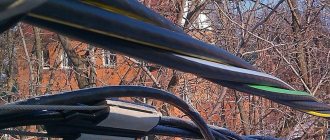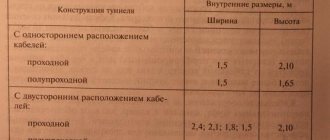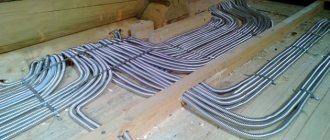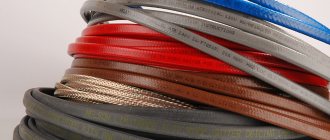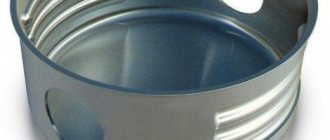Armored power cables are designed for laying power lines in the ground, under water or in the open, when there is a possibility of exposure to them mechanically or thermally.
To protect the cable from such influences, it is equipped with special steel armor wound from tape or wire.
It reliably protects the cable core from accidental damage by a shovel or stones during ground work, from fire and small rodents living in the soil.
In addition, armored cable has the following advantages:
- increased protection from corrosion and moisture;
- duration of work up to 50 years and above;
- protection against electromagnetic radiation;
- long shelf life;
- ease of installation, which does not require additional protective measures;
- versatility of application.
The main disadvantages of armored cable are increased weight and reduced flexibility.
Types of armored cables
1. Power armored cables with copper conductors can be single-wire or multi-core.
2. Power armored cables with aluminum conductors, which can be single or multi-wire.
3. A cable with galvanized protection and aluminum filling is better suited for installation in aggressive environments;
4. The steel cable protection is designed to withstand normal operating conditions.
Types of armored cable differ in their purpose. For installation of electrical networks, cables made of copper or aluminum are used. An optical cable is used to install communication lines.
The note! Single-core cable is used for installation of DC networks. Stranded - for alternating current.
How to protect an electrical cable?
To protect the electrical cable from mechanical damage or the influence of an aggressive environment, a special armored sheath is used. Such armored power cables are used in various industrial areas where there is a risk of power line breakage - in mines, quarries, when laying tunnels, on construction sites.
To protect the cable, it is placed in a sheath of steel tapes coated with an anti-corrosion compound. The armor prevents damage to the wire not only from the impact of a hand tool (for example, an accidental blow with a shovel or an ax), the teeth of pest animals, or the destruction of the structure on which the power line was fixed.
The protective armored shell will protect the wiring even under the mechanical impact of multi-ton mountain falls or during a mine collapse (flooding).
The range of armored cables is very large. Different brands are designed for different loads, location of operation, and environmental conditions in which the power line will be used.
To understand what we are talking about, you can examine the different types of armored cable in detail in the presented photos.
Armored Power Cable Brands
1. VBBShV armored power cable is a copper armored power cable with a number of cores from two to four. The veins have the shape of a sector or circle. Steel tapes act as an armor layer. The cable is insulated with colored plastic. 2. Armored power cable AVBbShv is an armored power cable made of aluminum. Has a single-wire or multi-wire core. Armored protection is a winding of steel tapes. The outer braid is made of painted plastic. 3. Power cable VkbShv – copper cable. The core is single-wire. The cable has steel armor made of strips. Insulated with polyethylene. 4. Cable PvBBShV – multi-core copper cable with the number of current-carrying cores from two to four. Two braids of steel serve as armor. Insulated with a strip of cross-linked polyethylene. This is an armored copper cable for laying in the ground.
Marking of cables with a layer of armor
Armored cables are available in various designs, which are indicated in the product labeling. The marking standard is the same for all types of cables and wires. The marking code consists of a set of letters and numbers, where each letter symbol indicates a specific design feature or technical characteristic of the product. The absence of a letter can also indicate certain properties of the product. So, below we will look at the letter and number markings of armored cables.
- Metal of current-carrying conductors: if it is “A”, then this is an armored aluminum cable, and if there is no letter, then this is an armored copper cable.
- Type of outer shell: “B” - made of PVC (polyvinyl chloride); “P” - polyethylene; “Shv” - in a PVC hose; “Shp” - polyethylene hose; "C" - lead sheath.
- Presence of a screen: the letter “E” in the marking indicates that this cable has a shielding layer, and its absence indicates the opposite.
- Insulation of current-carrying conductors: “B” - made of polyvinyl chloride (PVC); “Pv” - stitched polyethylene; “P” is a polymer composite material.
- The presence of a layer of armor: “B” - armor made of two steel strips, and an additional letter “b” for the absence of a bitumen cushion; “K” - armored with round wires.
- Cable cut shape: indicated by the letter “P” if it is flat; marking is not provided for a round product.
- According to the shape of the cores: monolithic ones are marked with the letter “o”, and stranded ones are marked with the letter “m”; segmental “s”, and round “k”.
In addition, the marking may contain other letters that determine the fire-fighting properties of the product. After the letter code there is a digital code, where the first digit indicates the number of cores, the second the cross-section of the current-carrying wires in mm² and the third the rated voltage.
Armored cable for underground installation
Power armored cable for laying in the ground is used for installation in tunnels or trenches. It differs favorably from the air method in the following characteristics:
• wiring does not sag under snow or ice; • there is no risk of getting caught by vehicles; • does not age morally; • serves for 50 years; • installation is cheaper; • not exposed to the sun, which can destroy the insulation; • has protection against corrosion; • does not require additional devices in the form of pipes; • hidden from people. • laying directly in the ground; • no risk of fire; • water resistance; • does not spoil the appearance of the site; • ease of installation; • does not rot.
What does an armored cable consist of?
Any cable consists of conductive cores and several layers of diverse sheathing. Copper or aluminum conductors are used for cable cores. These metals have the necessary strength, elasticity and good conductivity.
Power armored cables can be single or multi-core. The conductors in a two-core cable have the same cross-section. In other multi-core cables, one or two conductors have a smaller diameter; they serve as a neutral and ground wire.
The design of armored cables has the following features:
Conducting elements can be single or multiple. In shape they are round, sector, flat or divided into segments.
Each conductor has a personal sheath made of rubber, polyethylene, fluoroplastic, PVC, cable paper or low-flammable paper pulp. This individual insulation protects the conductors from interacting with each other.
A cable filler is placed in the space between the conductors, which can be rubber, paper, polymer mass, varieties of rubber and its mixtures with other substances, and even technical oil (it is used to fill the internal space of cables operating under high voltage).
Fillers ensure the tightness of the cable, give it strength and rigidity, and allow the elements inside the cable not to come into contact with each other.
All conductors are combined into a single element using belt insulation made from paper impregnated with a special composition.
A protective shell is located on top of the waist insulation. It is made from rubber, PVC, plastic or metals (steel, aluminum, lead). Thanks to the protective sheath, the cable acquires additional strength, rigidity and resistance to corrosion.
Between the armor and the protective shell there is a special cushion made of bitumen or cable fibers. This filler protects the internal cable protection from mechanical damage by armor elements.
What is construction expertise?Selling a share in an apartment
- Certificate of conformity for equipment
Power cable armor is made of steel in the form of strips or wires. A cable with tape protection made of galvanized or corrugated steel is used for laying power lines, provided that it is not subject to stretching. Corrugated steel armor is also used to protect optical or telephone cables.
Wire armor is ideal protection for cables that will be used underground or in other environments where they will be subject to tensile stress.
A polyvinyl chloride or polyethylene shell is located on top of the armor protection. It blocks access to steel armor from moisture and chemicals that may be in the environment.
The structure of the armored cable is clearly visible in cross-section - each component element is clearly visible and makes the design features of the power cable armoring more understandable.
Rules for laying electrical armored cables in the ground
• laid in a trench with a depth of 70 centimeters in open areas and from a meter in residential buildings; • the cable is checked for integrity; • the distance between other cables is at least 10 cm. It must be remembered that the higher the cable power, the greater the distance should be; • the cable is positioned straight and should not be twisted; • laying is carried out without tension; • the armor should be grounded; • sand should be poured onto the cable in a layer of 10 cm, then a layer of ordinary red brick and signal tape should be placed. And only after that they fill the trench with earth; • all layers of soil are compacted.
Some nuances need to be taken into account:
• if there is a heating main nearby, there must be a distance of at least two meters to it; • the distance from water supply networks must be at least a meter; • if it is necessary to lay through highways or railway tracks, you need to use pipes and ducts; • if it is necessary to cross the location of other cables, they are insulated with a layer of soil at least half a meter thick.
Important! Laying cables in the ground requires maintaining certain distances to networks, routes and communications.
There are three ways to lay cables in the ground:
• manual. The trench is dug with a shovel, the cable is laid and introduced into the room. The method is applicable on house or summer cottage plots; • mechanized. Suitable for industrial installation. A trench is dug with a bulldozer, then the cable is laid in the manner described above; • trenchless. Used for industrial purposes. A cable manager is used. This method can only be used to lay a single cable with aluminum filling and galvanization. Laying is done in open areas. If there are metal bridges or overpasses on the territory, then the cable is placed in non-flammable asbestos pipes. For wooden buildings, installation is carried out in steel pipes to avoid fire.
Important! Brands of armored cables for laying in the ground: VBShV and VBShVng, PvBbShv, AVBbShv, KVBbShv and OKLK.
The armored power cable is manufactured in Russia according to GOST.


